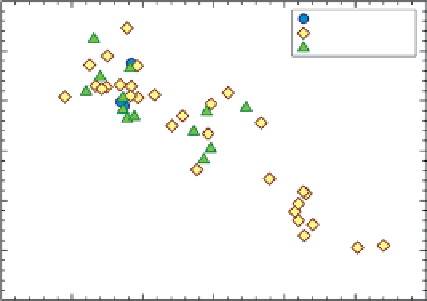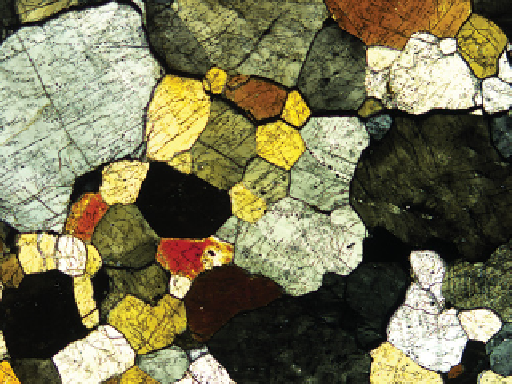Geology Reference
In-Depth Information
0.0
Early data
Antarctic ureilites
Other ureilites
-0.5
-1.0
-1.5
-2.0
-2.5
-3.0
70
75
80
85
Olivine mg#
90
95
100
Figure 5.5.
Plot of Δ
17
O vs. mg# for ureilites. The parameter
Δ
17
O gives the deviation of the O isotopic composition of a
meteorite from the terrestrial fractionation line and is a measure
of non-mass-dependent isotopic fractionation in the solar
system. Antarctic ureilites significantly extend the composi-
tional ranges of these parameters and provide the clearest evi-
dence for correlated compositional and isotopic heterogeneity.
Figure 5.6.
EET 99402 is an ultramafic brachinite with a well-
developed xenomorphic-granular texture. Olivines in this rock
show preferred orientation, explaining the common low bire-
fringence in the image, and support an igneous-cumulate-origin
for it. Image is 2.5 mm across.
The discussion of their mineralogy and petrology is
derived from
Day et al.
[2012a],
Floran et al.
[1978],
Goodrich et al.
[2010],
Johnson et al.
[1977],
Mittlefehldt
et al.
[2003],
Shearer et al.
[2010],
Swindle et al.
[1998],
and
Warren and Kallemeyn
[1989]. Brachina is a fine-
grained ultramafic rock dominated by olivine (~80 vol.%).
Paired meteorites EET 99402 and EET 99407 (hereafter
EET 99402/7) are coarse-grained, moderately shocked
olivine-dominated rocks (Figure 5.6), while paired mete-
orites gRA 06128 and gRA 06129 (hereafter gRA
06128/9) are mafic rocks dominated by plagioclase
(~80 vol.%) (Figure 5.7; Plate 49). However, gRA 06128/9
are very much atypical, and most brachinites contain bet-
ween 79 and 93 vol.% olivine. All brachinites contain
high-Ca clinopyroxene, either augite or diopside, at
modal abundances of 4-15 vol.%. low-Ca pyroxene has
been reported from only about half of all brachinites,
and is typically <2 vol.% when modes are reported. An
exception is NWA 595, where orthopyroxene reportedly
makes up to ~15 vol.% in some thin sections. Plagioclase
is present in about two thirds of all brachinites but is
highly variable in abundance. Excluding gRA 06128/9,
plagioclase varies from being a trace phase to making up
~10 vol.%. Chromite, sulfide, and metal are common
trace to minor phases.
Brachinites commonly have equigranular textures
with subhedral to anhedral grains joined at 120° triple
junctions (Figure 5.6). In some cases, olivine grains are
prismatic with lineations and possible foliations defined
by grain alignments. gRA 06128/9 have granoblastic to
equigranular textures and include bands of finer-grained
granoblastic texture. grain size is quite variable, from
5.5. ASTEROIDAl CRUST-MANTlE SUITE:
BRACHINITES
The brachinite group membership is poorly defined
because there are significant petrologic, compositional,
and isotopic variations among bona fide brachinites
(Plates 48 and 49), and there are numerous achondrites
with generally similar petrologic, compositional, and
isotopic characteristics such that the boundaries of the
brachinite group are unclear. Indeed, one of the brachi-
nites that is most clearly distinct from the group “type”
properties is the eponymous Brachina! The question of
how isotopically heterogeneous a single achondrite par-
ent asteroid can be is unresolved [e.g.,
Greenwood et al.
,
2008], but regardless, isotopically diverse brachinites are
considered to hail from a single asteroid by virtue of pet-
rological similarities [e.g.,
Rumble et al.
, 2008].
As of September 2013, the Meteoritical Bulletin
Database lists 34 named meteorites as brachinites. There
are six achondrites classified as ungrouped that are often
considered (with differing degrees of nervousness) as bra-
chinites; Divnoe, gRA 06128, gRA 06129, Northwest
Africa (NWA) 1500, NWA 5400, and NWA 6077. Zag (b)
is officially classified as a winonaite, but its silicates are
far too oxidized to support that classification. It, too, is
often considered a potential brachinite. Because of the
uncertainties surrounding the definition of brachinite,
these additional meteorites will be discussed here along
with the bona fide brachinites.
Brachinites are ultramafic and mafic rocks whose
origin remains elusive. Petrologically, they are diverse.


